Study on Lifetime Performance Evaluation of a Precast Prestressed Concrete Frame in Chloride Environments
Abstract
:1. Introduction
2. Lifetime Assessment Framework
3. Reliability Model
4. Time-Dependent Probability Models for Each Stage
4.1. Corrosion Initiation Stage
4.2. Corrosion Progression Stage
4.3. Corrosion Failure Stage
5. Service Life Prediction
5.1. Engineering Case Study
5.2. Corrosion Initiation Stage
5.3. Corrosion Progression Stage
5.4. Corrosion Failure Stage
5.5. Lifetime Seismic Performance Evaluation Based on the Path Probability Model
6. Conclusions
- The initial corrosion time of reinforcement was highly sensitive to the chloride ion diffusion coefficient. In the composite layer between the precast part and the cast-in-place part, the higher chloride ion diffusion coefficient would lead to early corrosion in the precast prestressed concrete frame, consequently reducing the durability of the structural system.
- Both the depassivation of reinforcement and the limit state of normal service was highly sensitive to the chloride ion diffusion coefficient in the composite layer. For structures adopting these two limit states as design failure criteria, it was crucial to focus on improving the waterproofing performance of the joint area to extend the service life of the structure.
- Using the time-dependent reliability model curves of structural capacity limit states under different performance levels, it was observed that the seismic performance of the precast prestressed concrete frame structures gradually decreased with the development of corrosion. The presence of the composite layer led to a more severe deterioration in the time-dependent seismic performance of the precast prestressed concrete frame structure compared to the cast-in-place structure.
Author Contributions
Funding
Institutional Review Board Statement
Informed Consent Statement
Data Availability Statement
Conflicts of Interest
References
- Imperatore, S.; Rinaldi, Z.; Drago, C. Degradation relationships for the mechanical properties of corroded steel rebars. Const. Build. Mater. 2017, 148, 219–230. [Google Scholar] [CrossRef]
- Bazan, A.M.; Gonzalez, M.D.; Alberti, M.G.; Galvez, J.C. Influence of the loading speed on the ductility properties of corroded reinforcing bars in concrete. Materials 2019, 12, 965. [Google Scholar] [CrossRef] [PubMed]
- Chen, M.; Qian, H. Effects of natural minor corrosion levels on mechanical property and bond anchorage behavior of CRB600H steel bars. Const. Build. Mater. 2022, 340, 127660. [Google Scholar] [CrossRef]
- Al-Sulaimani, G.J.; Kaleemullah, M.; Basunbul, I.A.; Rasheeduzzafar. Influence of corrosion and cracking on bond behavior and strength of reinforced concrete members. ACI Struct. J. 1990, 87, 220–231. [Google Scholar]
- Almusallam, A.A.; Al-Gahtani, A.S.; Aziz, A.R.; Rasheeduzzafar. Effect of reinforcement corrosion on bond strength. Const. Build. Mater. 1996, 10, 123–129. [Google Scholar] [CrossRef]
- Lee, H.S.; Noguchi, T.; Tomosawa, F. Evaluation of the bond properties between concrete and reinforcement as a function of the degree of reinforcement corrosion. Cem. Concr. Res. 2002, 32, 1313–1318. [Google Scholar] [CrossRef]
- Liu, T.W.; Li, X.P.; Che, J.L. Study on bond performance between corroded deformed steel bar and DS-ECC. Materials 2022, 15, 9009. [Google Scholar] [CrossRef]
- Yang, J.; Guo, T.; Chai, S.; Li, A.Q. Cyclic tests on beam-column joints of SCOPE system with different key slot lengths and corrosion levels. Eng. Struct. 2019, 201, 109406. [Google Scholar] [CrossRef]
- Yang, J.; Guo, T.; Chai, S. Experimental and numerical investigation on seismic behavior of corroded beam-column joints of precast prestressed concrete frame under given corrosion levels. Structures 2020, 27, 1209–1221. [Google Scholar] [CrossRef]
- Zhang, X.C.; Li, B. Seismic performance of exterior reinforced concrete beam-column joint with corroded reinforcement. Eng. Struct. 2021, 228, 111556. [Google Scholar] [CrossRef]
- Yang, J.; Guo, T.; Luo, D.; Liu, Z.X. Multiscale modeling and seismic fragility analysis of corroded precast concrete frame. J. Perform. Constr. Fac. 2021, 35, 04020128. [Google Scholar] [CrossRef]
- Choe, D.E.; Gardonia, P.; Rosowskya, D.; Haukaas, T. Probabilistic capacity models and seismic fragility estimates for RC columns subject to corrosion. Reliab. Eng. Syst. Safe. 2008, 93, 383–393. [Google Scholar] [CrossRef]
- Liu, X.X.; Zhang, W.B.; Sun, P.; Liu, M. Time-dependent seismic fragility of typical concrete girder bridges under chloride-induced corrosion. Materials 2022, 15, 5020. [Google Scholar] [CrossRef] [PubMed]
- Weyers, R.E. Service life model for concrete structures in chloride laden environments. ACI Mater. J. 1998, 95, 445–453. [Google Scholar]
- Darmawan, M.S. Pitting corrosion model for reinforced concrete structures in a chloride environment. Mag. Concrete Res. 2010, 62, 91–101. [Google Scholar] [CrossRef]
- Naser, M.Z. Digital twin for next gen concretes: On-demand tuning of vulnerable mixtures through Explainable and Anomalous Machine Learning. Cement Concrete Comp. 2022, 132, 104640. [Google Scholar] [CrossRef]
- Lu, C.; Dong, B.Q.; Pan, J.L.; Shan, Q.F.; Hanif, A.; Yin, W.Y. An investigation on the behavior of a new connection for precast structures under reverse cyclic loading. Eng. Struct. 2018, 169, 131–140. [Google Scholar] [CrossRef]
- Dong, B.Q.; Lu, C.; Pan, J.L.; Shan, Q.F.; Yin, W.Y. Mechanical behavior of a novel precast beam-to-column connection with U-shaped bars and engineered cementitious composites. Adv. Struct. Eng. 2018, 21, 1963–1976. [Google Scholar] [CrossRef]
- Brunesi, E.; Nascimbene, R.; Peloso, S. Evaluation of the seismic response of precast wall connections: Experimental observations and numerical modeling. J. Earthq. Eng. 2020, 24, 1057–1082. [Google Scholar] [CrossRef]
- Mpampatsikos, V.; Bressanelli, M.E.; Belleri, A.; Nascimbene, R. A non-dimensional parametric approach for the design of PT tendons and mild steel dissipaters in precast rocking walls. Eng. Struct. 2020, 212, 110513. [Google Scholar] [CrossRef]
- Jin, W.L.; Zhao, Y.X. Durability of Concrete Structures; Science Press: Beijing, China, 2014. [Google Scholar]
- Li, C.Q. Reliability based service life prediction of corrosion affected concrete structures. J. Struct. Eng. 2004, 130, 1570–1577. [Google Scholar]
- Zhang, D.; Zeng, Y.; Fang, M.; Jin, W. Service Life Prediction of Precast Concrete Structures Exposed to Chloride Environment. Adv. Civ. Eng. 2019, 2019, 3216328. [Google Scholar] [CrossRef]
- CEB-FIP (International Federation for Structural Concrete). Fib Bulletin No 34. Model Code for Service Life Design; CEB-FIP (International Federation for Structural Concrete): Lausanne, Switzerland, 2006. [Google Scholar]
- DB33-T1128-2016; Technical Specifications for Durability of Concrete Structures. Zhejiang Provincial Department of Housing and Urban-Rural Development: Hangzhou, China, 2016.
- Chen, W.G.; Zhu, H.T.; He, Z.H.; Yang, L.; Zhao, L.P.; Wen, C.C. Experimental investigation on chloride-ion penetration resistance of slag containing fiber-reinforced concrete under drying-wetting cycles. Const. Build. Mater. 2021, 274, 121829. [Google Scholar] [CrossRef]
- Collepardi, M.; Marcialis, A.; Turriziani, R. Penetration of chloride ions into cement pastes and concretes. J. Am. Ceram. Soc. 1972, 55, 534–535. [Google Scholar] [CrossRef]
- Lu, F.Y.; Cai, R.; Yu, B. Investigation of computational model for surface chloride concentration of concrete in marine atmosphere zone. Ocean Eng. 2017, 138, 105–111. [Google Scholar]
- Guo, Y.; Trejo, D.; Yim, S. New model for estimating the time-variant seismic performance of corroding RC bridge columns. J. Struct. Eng. 2015, 141, 04014158. [Google Scholar] [CrossRef]
- Liu, Q.F.; Su, R.K.L. A Wasserstein distance-based analogous method to predict distribution of non-uniform corrosion on reinforcements in concrete. Const. Build. Mater. 2019, 226, 965–975. [Google Scholar] [CrossRef]
- Stewart, M.G.; Al-Harthy, A. Pitting corrosion and structural reliability of corroding RC structures: Experimental data and probabilistic analysis. Reliab. Eng. Syst. Safe. 2008, 93, 373–382. [Google Scholar] [CrossRef]
- Sung, Y.C.; Su, C.K. Time-dependent seismic fragility curves on optimal retrofitting of neutralised reinforced concrete bridges. Struct. Infrastruct. Eng. 2011, 7, 797–805. [Google Scholar] [CrossRef]
- Liu, T.; Weyers, R.W. Modeling the dynamic corrosion process in chloride contaminated concrete structures. Cement Concr. Res. 1998, 28, 365–379. [Google Scholar] [CrossRef]
- Vu, K.A.T.; Stewart, M.G. Structural reliability of concrete bridges including improved chloride-induced corrosion models. Struct. Saf. 2000, 22, 313–333. [Google Scholar] [CrossRef]
- Val, D.V.; Melchers, R.E. Reliability of deteriorating RC slab bridges. J. Struct. Eng. 1997, 123, 1638–1644. [Google Scholar] [CrossRef]
- Vidal, T.; Castel, A.; François, R. Analyzing crack width to predict corrosion in reinforced concrete. Cement Concr. Res. 2004, 34, 165–174. [Google Scholar] [CrossRef]
- Vamvatsikos, D.; Cornell, C.A. Incremental dynamic analysis. Earthq. Eng. Struct. D 2002, 31, 491–514. [Google Scholar] [CrossRef]
- Xue, Q.; Wu, C.W.; Chen, C.C.; Chen, K.C. The draft code for performance-based seismic design of buildings in Taiwan. Eng. Struct. 2008, 30, 1535–1547. [Google Scholar] [CrossRef]
- Ibrahim, Y.E.; El-Shami, M.M. Seismic fragility curves for mid-rise reinforced concrete frames in Kingdom of Saudi Arabia. IES J. Part A Civ. Struct. Eng. 2011, 4, 213–223. [Google Scholar] [CrossRef]
- Li, Q.W.; Li, K.F.; Zhou, X.G.; Zhang, Q.M.; Fan, Z.H. Model-based durability design of concrete structures in Hong Kong-Zhuhai-Macau sea link project. Struct. Saf. 2015, 53, 1–12. [Google Scholar] [CrossRef]
- DuraCrete. Statistical Quantification of the Variables in the Limit State Functions; The European Union Brite EuRam III; Contract BRPRCT95—0132—Project BE95-1347/R9; CUR: Gouda, The Netherlands, 2000. [Google Scholar]
- Hu, S.C.; Wang, Z.Y.; Guo, Y. Life-cycle seismic fragility assessment of existing RC bridges subject to chloride-induced corrosion in marine environment. Adv. Civ. Eng. 2021, 2021, 9640521. [Google Scholar] [CrossRef]
- ACI318-08; Building Code Requirements for Structural Concrete and Commentary. American Concrete Institute: Farmington Hills, MI, USA, 2008.


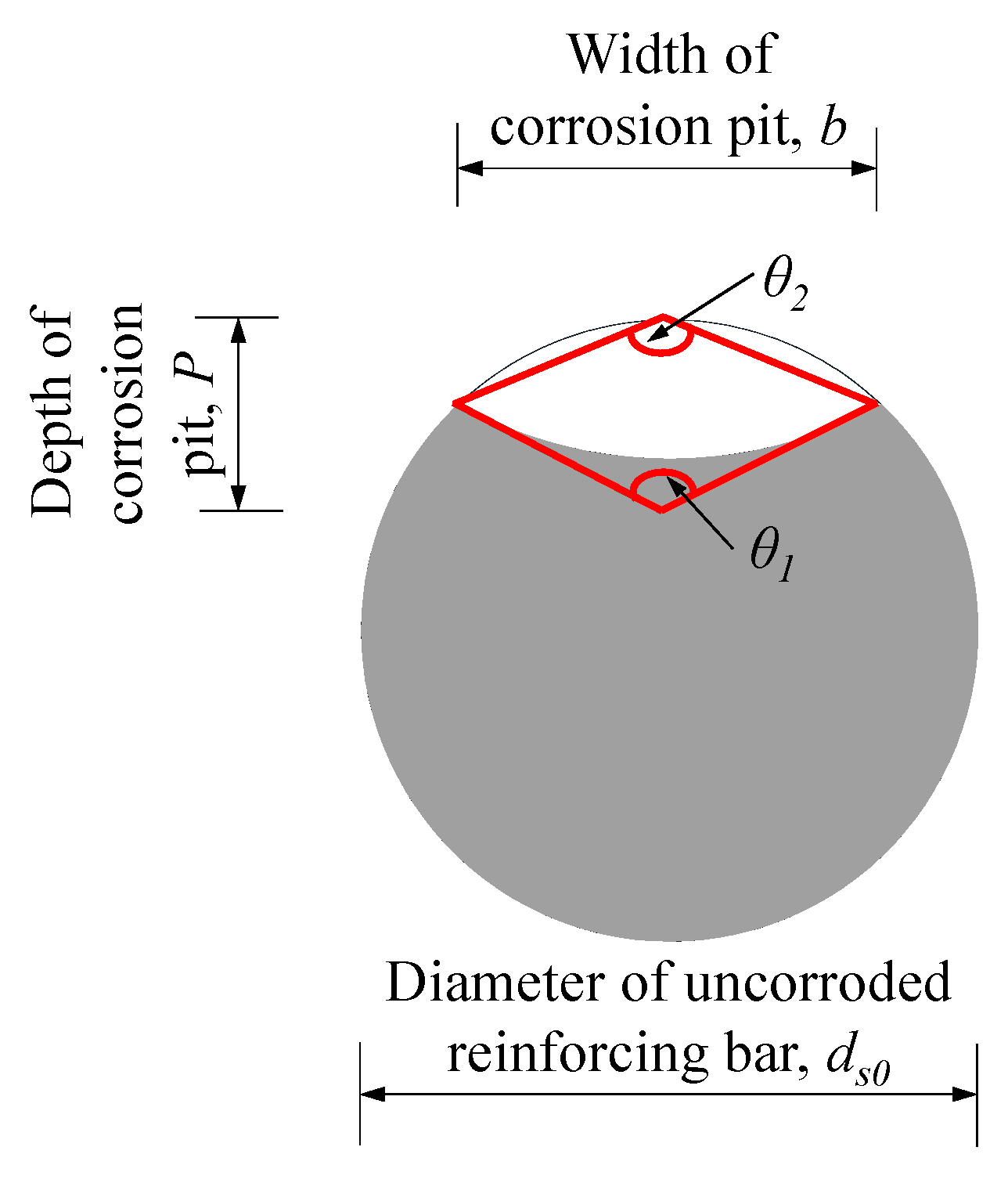

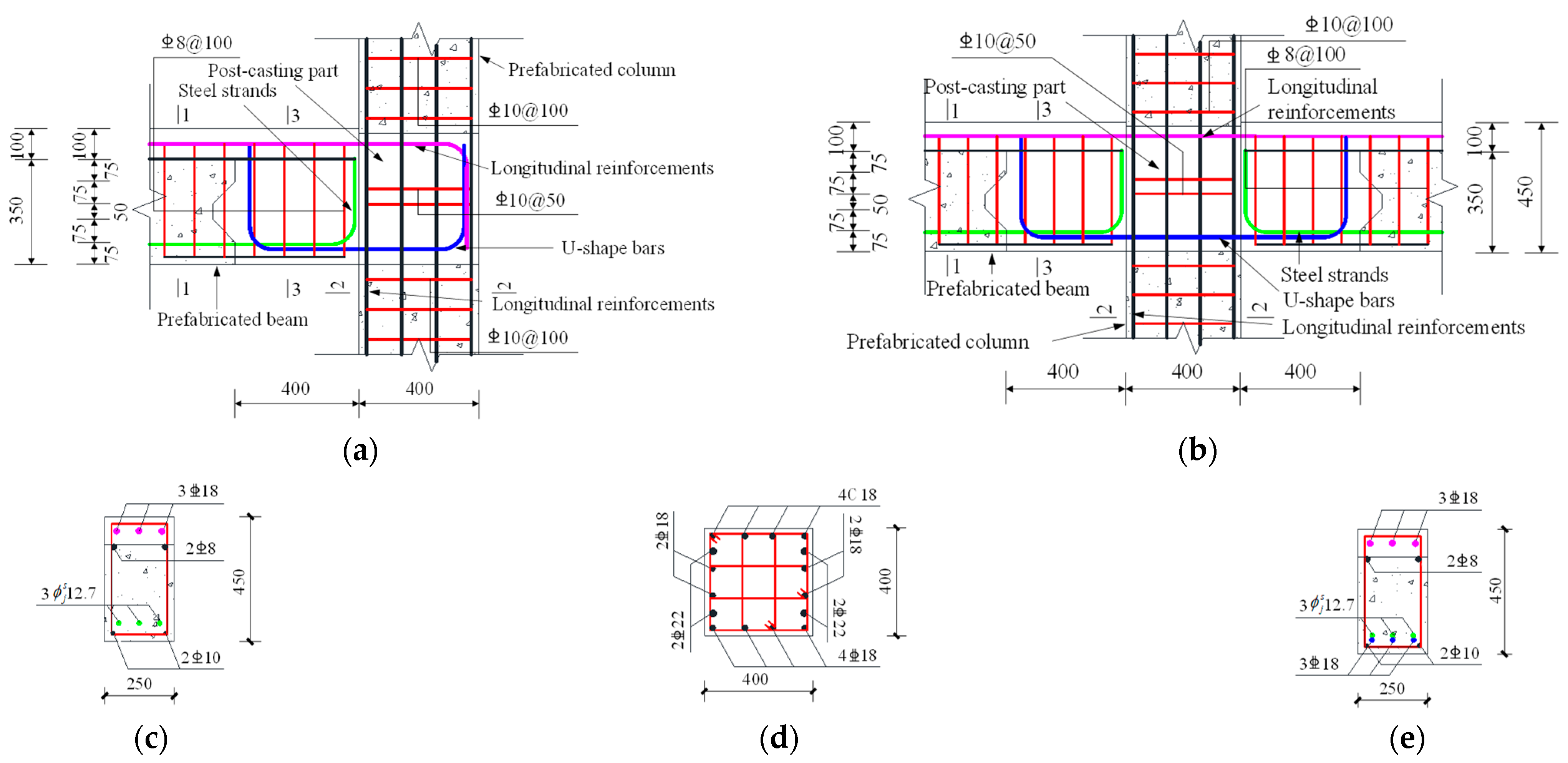



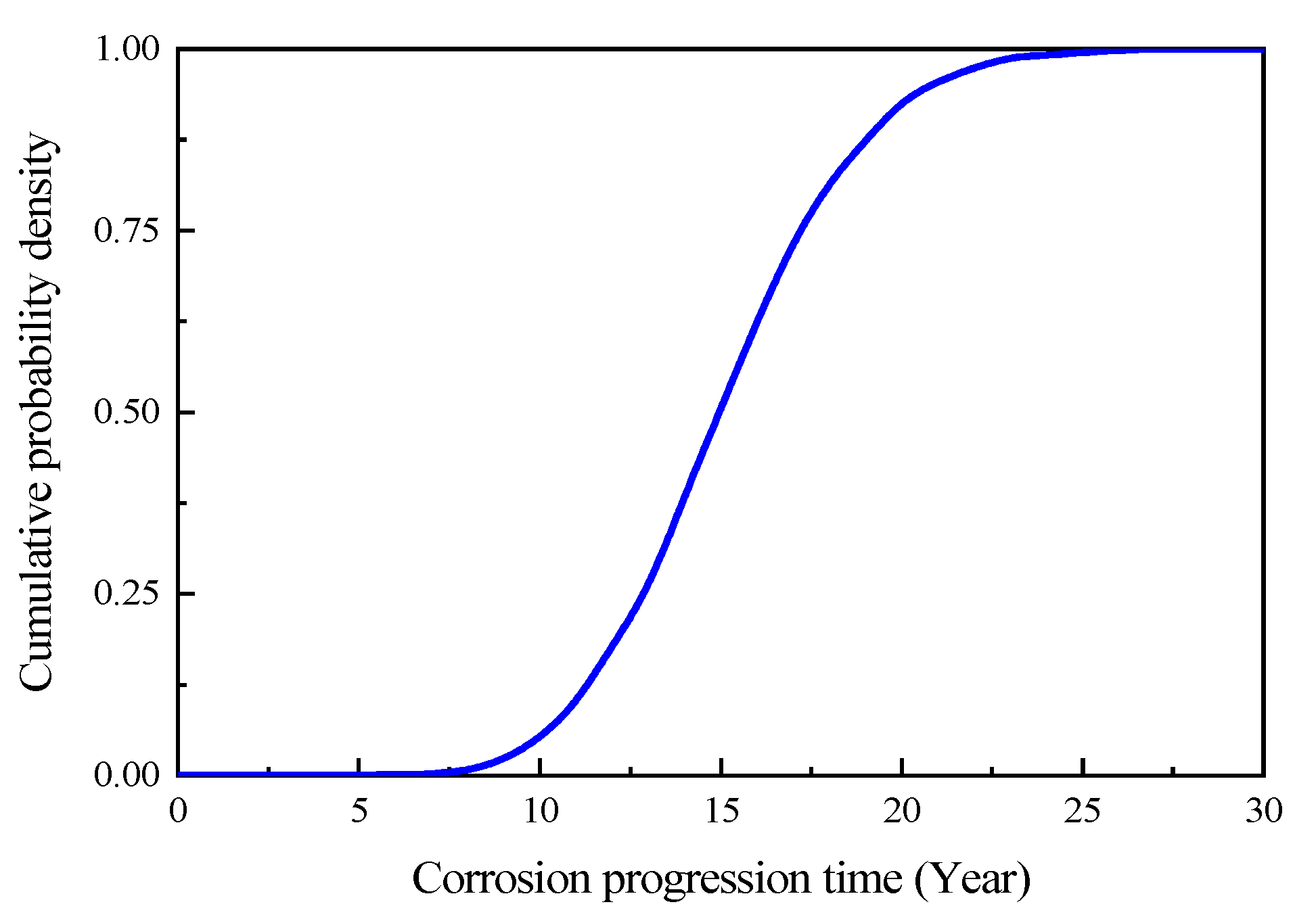

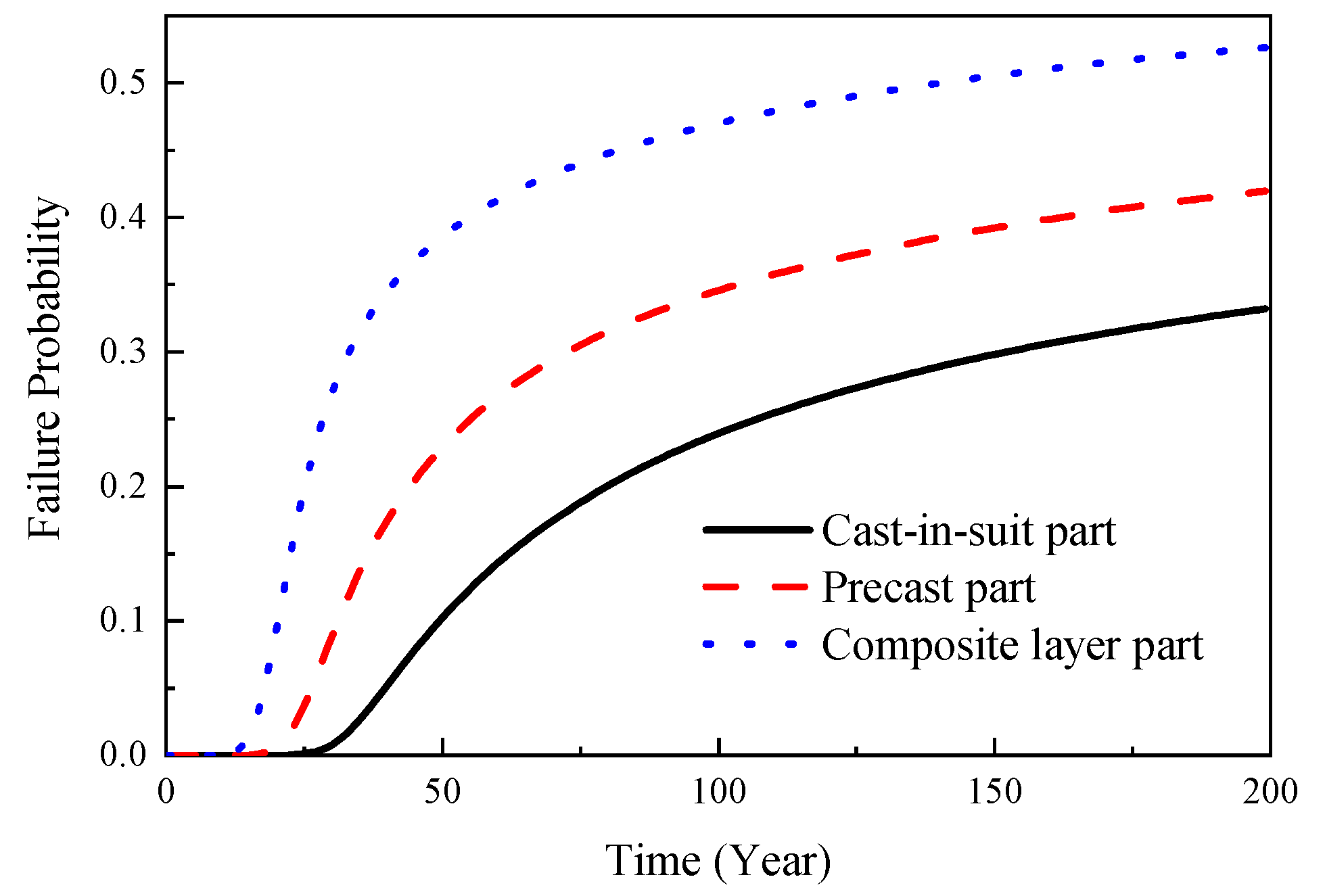
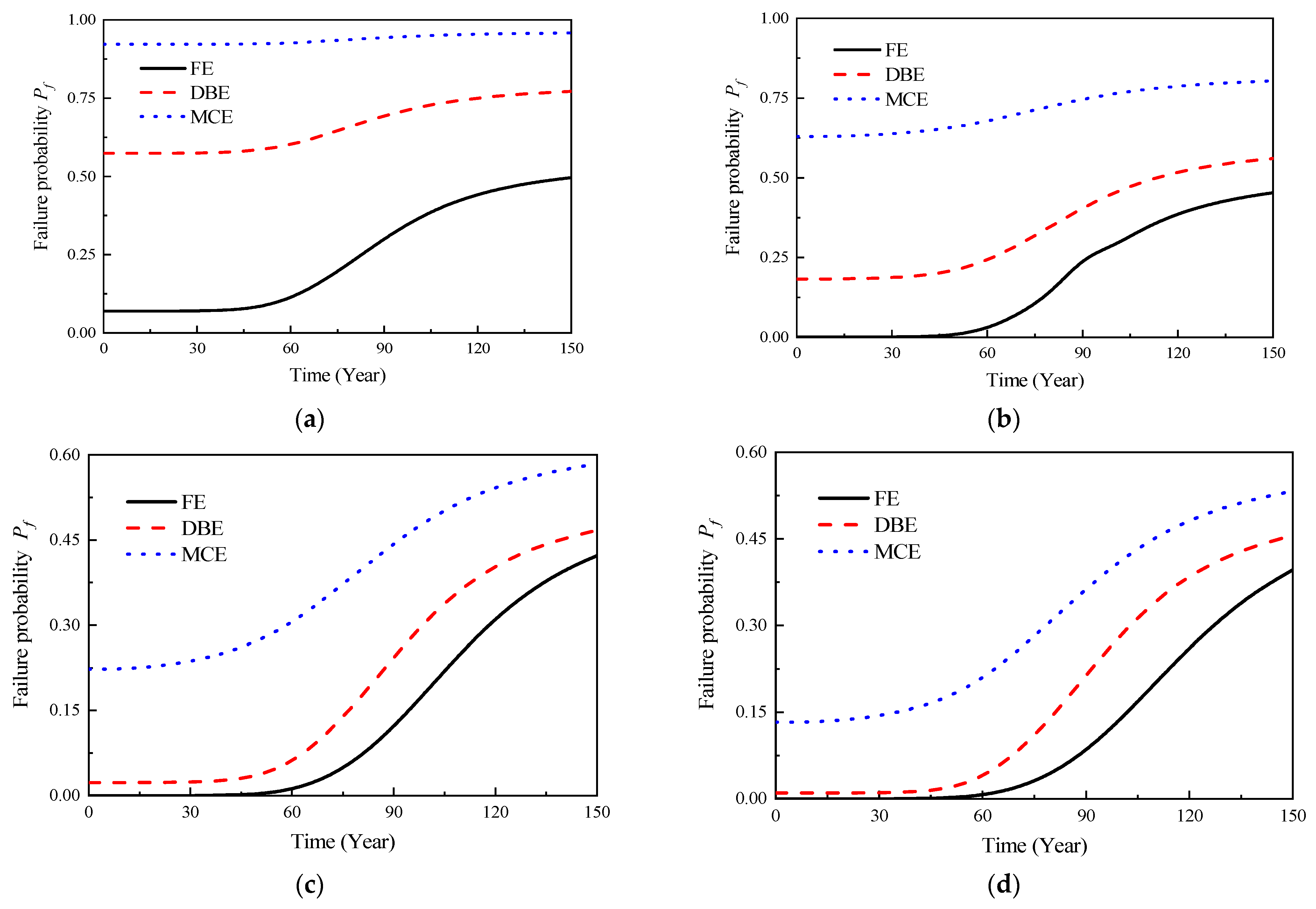
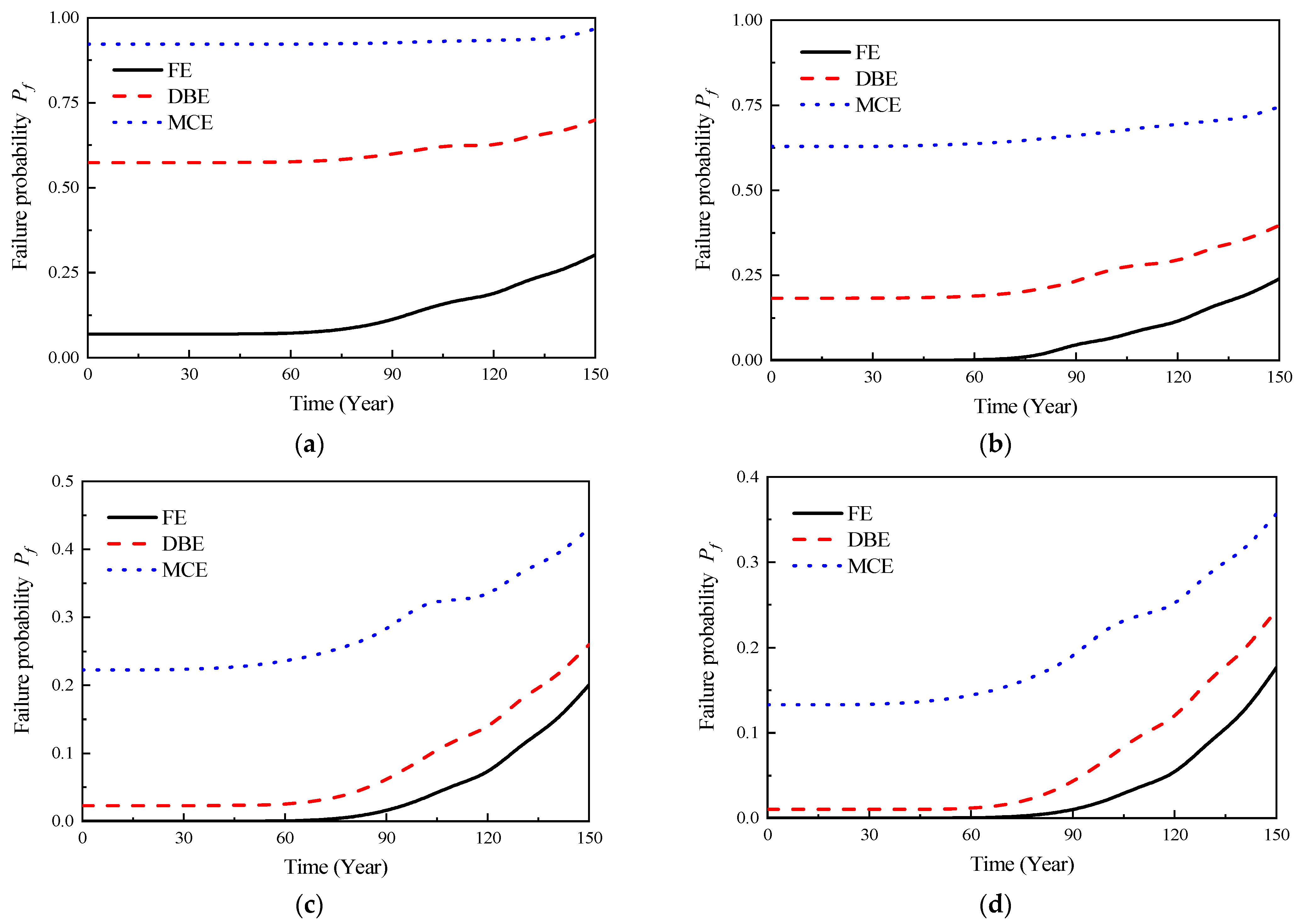
| Durability Limit State | [β] | [Pf] | Reference |
|---|---|---|---|
| Corrosion initiation | 1.3 | 9.70 × 10−2 | [24] |
| Corrosion-induced crack reaching the maximum acceptable level | 1.5 | 6.68 × 10−2 | [25] |
| Input Parameter | Unit | Average Value | Coefficient of Variation | Distribution Pattern | Reference |
|---|---|---|---|---|---|
| Surface chloride ion concentration Cs | % | 0.13 | 0.7 | Lognormal distribution | [40] |
| Critical chloride ion concentration Ccr | % | 0.12 | 0.6 | Lognormal distribution | [34] |
| Chloride ion diffusion coefficient D0 (Cast-in-site part) | mm2/a | 31.5 | 0.2 | Lognormal distribution | [23] |
| Chloride ion diffusion coefficient D0 (Precast part) | mm2/a | 63 | 0.2 | Lognormal distribution | [23] |
| Chloride ion diffusion coefficient D0 (Composite layer part) | mm2/a | 158 | 0.2 | Lognormal distribution | [27] |
| Protective layer thickness x (Cast-in-situ part) | mm | 50 | 0.05 | Normal distribution | [34] |
| Protective layer thickness x (Precast part) | mm | 67 | 0.05 | Normal distribution | [34] |
| Protective layer thickness x (Composite layer part) | mm | 50 | 0.05 | Normal distribution | [34] |
| n | - | 0.362 | 0.677 | Beta distribution | [41,42] |
| kl | - | 0.832 | 0.028 | Normal distribution | [41,42] |
| ke | - | 0.676 | 0.168 | Gamma distribution | [41,42] |
| ke | - | 1 | - | - | [41,42] |
Disclaimer/Publisher’s Note: The statements, opinions and data contained in all publications are solely those of the individual author(s) and contributor(s) and not of MDPI and/or the editor(s). MDPI and/or the editor(s) disclaim responsibility for any injury to people or property resulting from any ideas, methods, instructions or products referred to in the content. |
© 2023 by the authors. Licensee MDPI, Basel, Switzerland. This article is an open access article distributed under the terms and conditions of the Creative Commons Attribution (CC BY) license (https://creativecommons.org/licenses/by/4.0/).
Share and Cite
Yang, J.; Yuan, Z.; Liu, J.; Yu, S. Study on Lifetime Performance Evaluation of a Precast Prestressed Concrete Frame in Chloride Environments. Materials 2023, 16, 6666. https://doi.org/10.3390/ma16206666
Yang J, Yuan Z, Liu J, Yu S. Study on Lifetime Performance Evaluation of a Precast Prestressed Concrete Frame in Chloride Environments. Materials. 2023; 16(20):6666. https://doi.org/10.3390/ma16206666
Chicago/Turabian StyleYang, Jun, Zhaoming Yuan, Jie Liu, and Shuqi Yu. 2023. "Study on Lifetime Performance Evaluation of a Precast Prestressed Concrete Frame in Chloride Environments" Materials 16, no. 20: 6666. https://doi.org/10.3390/ma16206666






